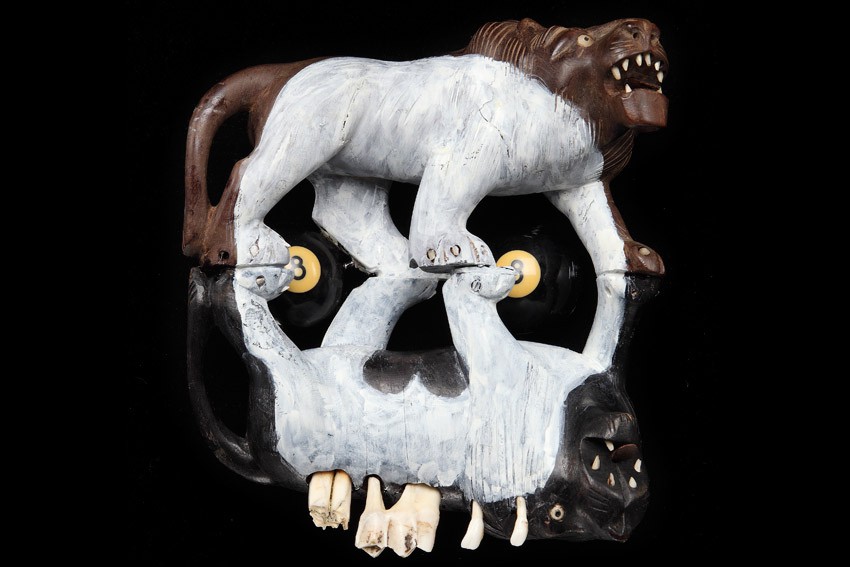Review: Dark Heart

Rub our eyes
The Reverend Frazer in David Malouf’s novel Remembering Babylon, observes that ‘The very habit and faculty that makes apprehensible to us what is known and expected dulls our sensitivity to other forms… We must rub our eyes and look again, clear our minds of what we are looking for to see what is there’. Author Alice Brittan, in commenting on this passage, treats it as an expression of Malouf’s idea of the drug of analogy. The analogy (an extended comparison between two different things) serves, she believes, to “disguise the unknown as the familiar”. I carried these ideas into Dark Heart. I anticipated that the exhibition would provide some new information about current directions in contemporary Australian art. But I also hoped that the exhibition might deliver some insights into the now of Australian lived experience. The timing of this Adelaide Biennial was significant. The project came off the back of the 2012 Adelaide Biennial, Parallel Collisions. This previous project projected the intensity of suspended judgement mindsets associated with postmodernist discourse. This was evident in the ‘ tracking shot’ dynamic, which spilled from the exhibition’s epicentre in the downstairs gallery to keep viewers in a state of constant negotiation between what we know of the past and what contemporary experience is telling us. The curators declared that they were not interested in curating in “an authorial, singular position” but were more interested in the way ideas can “rise up through a space”. In this regard Dark Heart is in a different postcode. Curator Nick Mitzevitch’s intention to create an “emotional and immersive” exhibition experience has meant that each work, while aware of and informed by proximities, functions within its own space. There is, now trademark, visual theatrics of low ambient light, dramatic spots and floods and dark walls. The viewer is very much cast as audience. The aesthetic heft of this style of presentation predisposes a sense of drama and significantly an awareness of materiality as central to the transaction between viewers and works. Back to Malouf’s drug of analogy. The question is, have the artists forced analogies on themselves and viewers? There is no ready answer to this. Warwick Thornton’s evocation (Rebirth) of Albert Namatjira’s circumstance of being in, of and separated from country, for example, uses the visual analogy of jump cuts and absences to suggest a fragmented and continuing story. Fiona Hall communicates menacing wunderkammer connections (Happy Hour) between ageold impulses to understand the world and contemporary obsessions with exploitation against a backdrop of time running out. The multiple cut out /pin up shapes in Sally Smart’s large wall installation (The Choreography of Cutting) mimic the dynamics of choreographed bodies in motion. The flopping, peeling instability of Caroline Rothwell’s various ‘reconfigurations’ of machines that might save the world amuse but inspire little confidence in a future dependent on neosteampunk inventions. Such examples exemplify the confidence all Dark Heart artists have in employing powerful analogies to tell their stories. The slippery part of this is the business of casting the unfamiliar as familiar (and thus obscuring its true nature) or creating fresh analogies that somehow close the gap between artist, idea and audience. Because the works are, generally speaking, very conscious of the materiality of expression, this factor plays a significant role in convincing the viewer to look longer and closer. Such a dynamic is a given with Julia deVille’s impeccably taxidermied and bejeweled mortes. A similar comment can be made of Alex Seton’s remarkable carved marble live vests. But it is also present as an engagement factor in Richard Lewer’s low-tech but almost unbearably intense animation about human grief and courage. Images 1. Fiona Hall, Out of my tree, 2013, mixed media installation, dimensions variable, © Fiona Hall. Courtesy the artist and Roslyn Oxley9 Gallery, Sydney. 2. Sally Smart, The Choreography of Cutting, (Spring), 2013–14, installation, mixed media, dimensions variable, © Sally Smart. Courtesy the artist and BREENSPACE, Sydney and Greenaway Art Gallery, Adelaide.